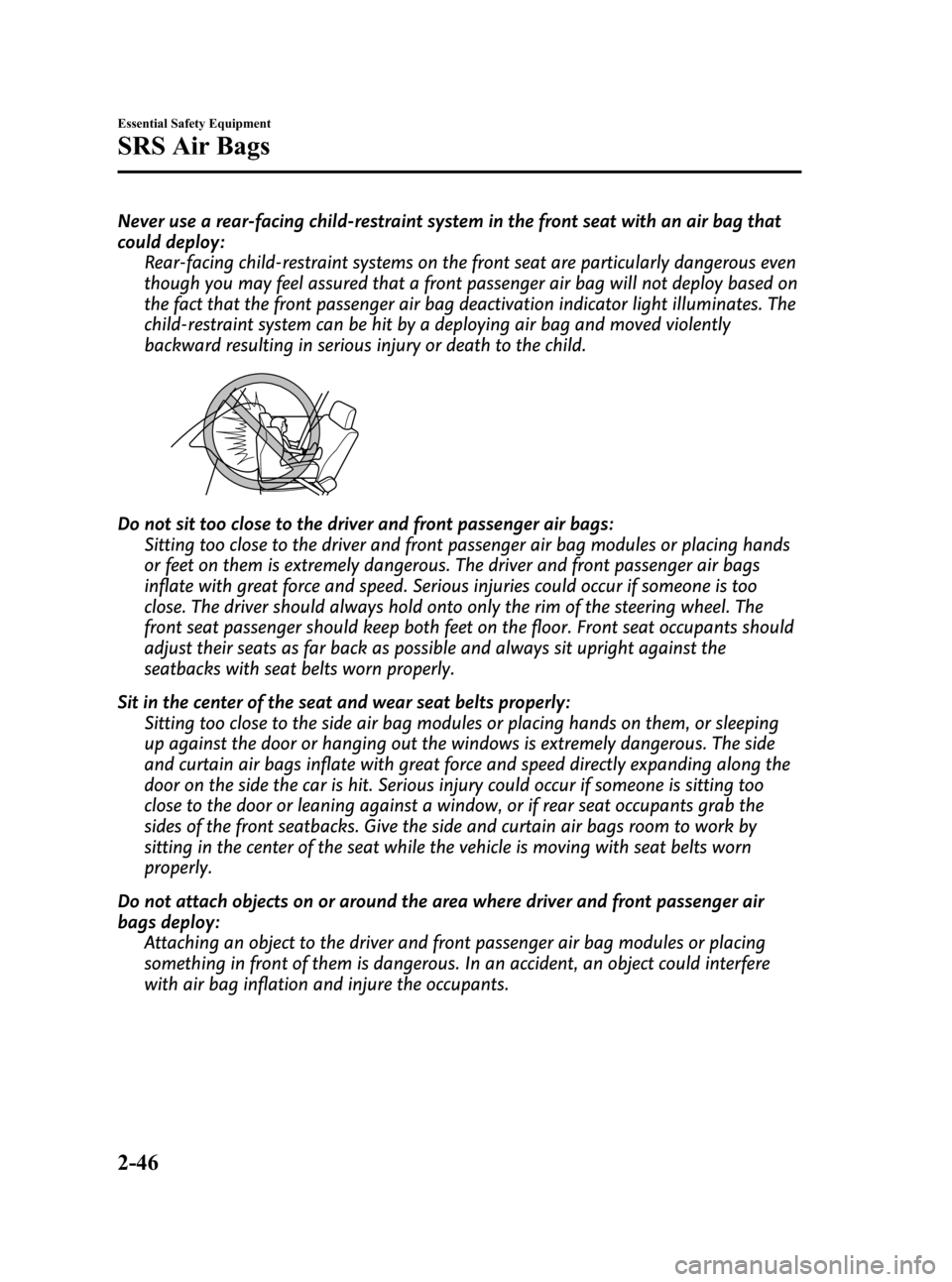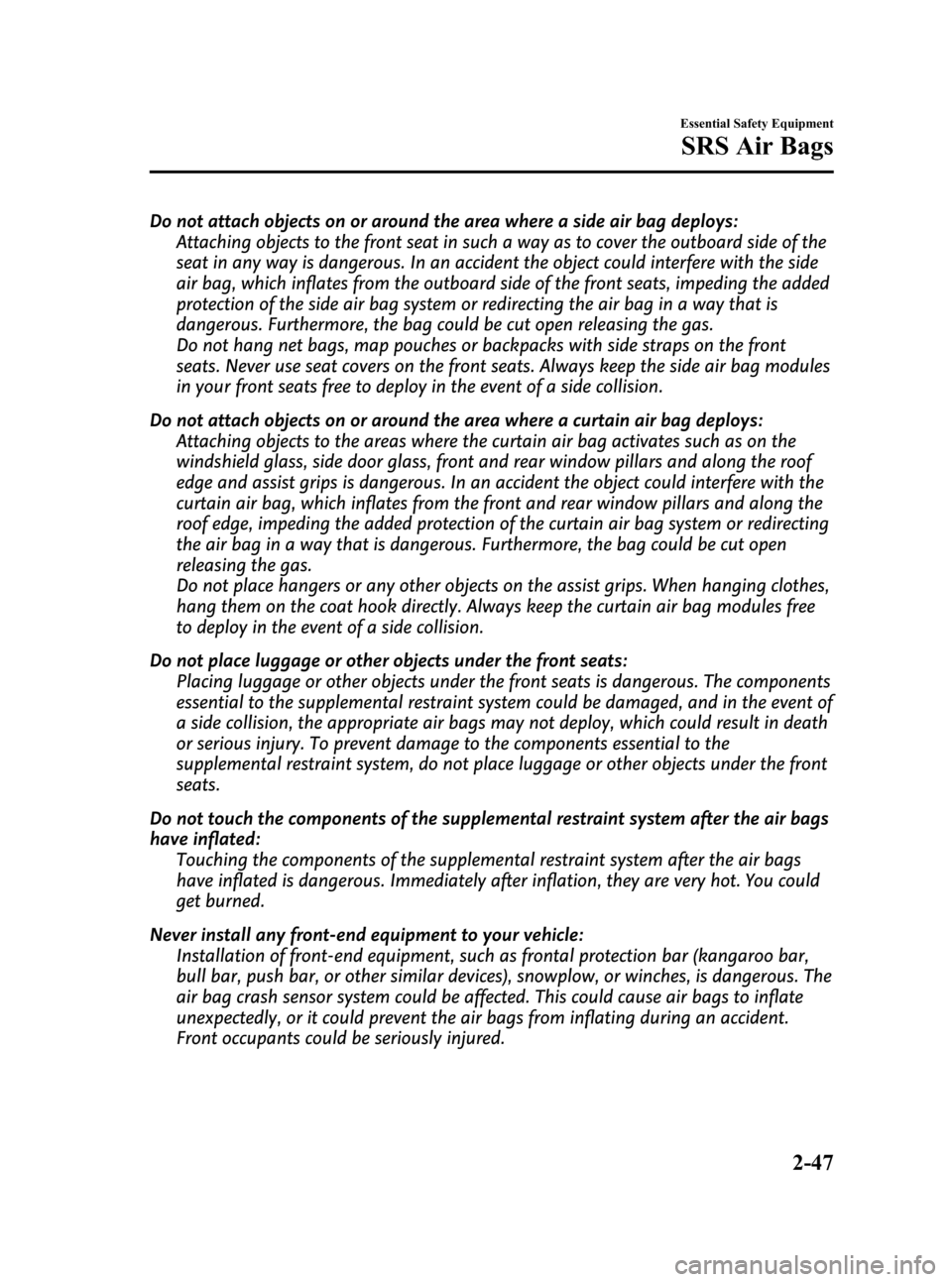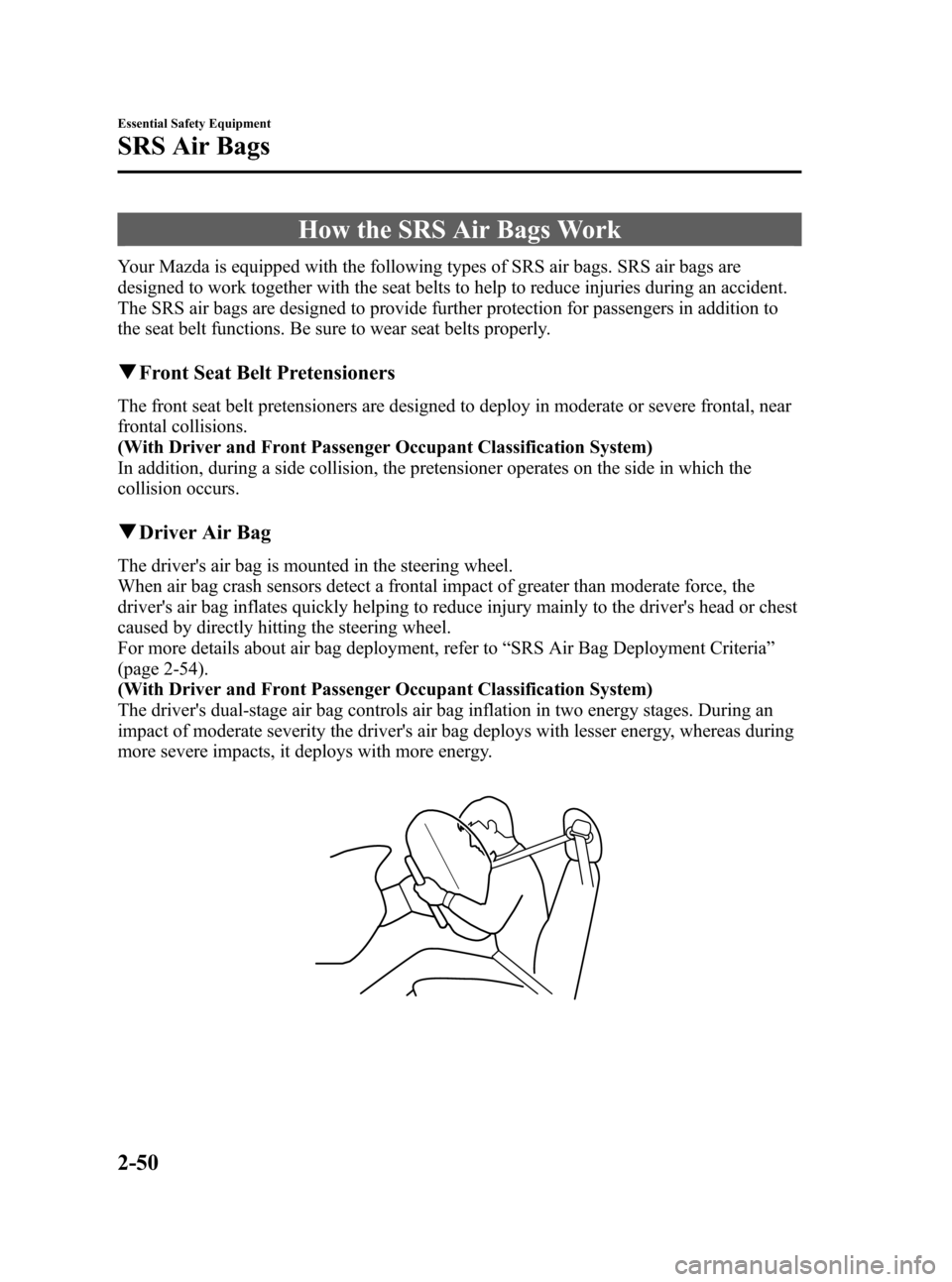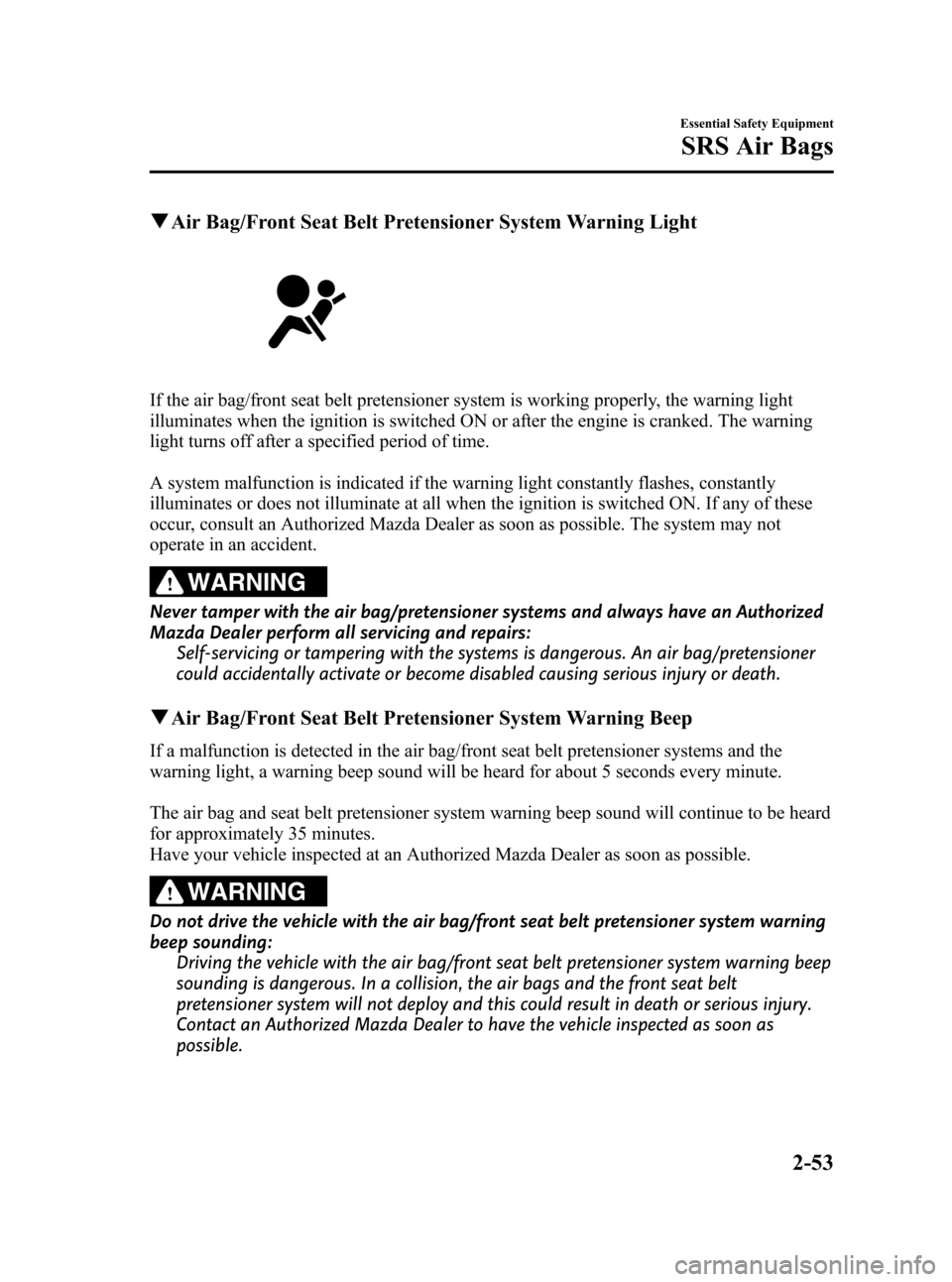MAZDA MODEL 3 HATCHBACK 2012 (in English) Repair Manual
Manufacturer: MAZDA, Model Year: 2012, Model line: MODEL 3 HATCHBACK, Model: MAZDA MODEL 3 HATCHBACK 2012Pages: 525, PDF Size: 5.95 MB
Page 61 of 525

Black plate (60,1)
Never use a rear-facing child-restraint system in the front seat with an air bag that
could deploy:Rear-facing child-restraint systems on the front seat are particularly dangerous even
though you may feel assured that a front passenger air bag will not deploy based on
the fact that the front passenger air bag deactivation indicator light illuminates. The
child-restraint system can be hit by a deploying air bag and moved violently
backward resulting in serious injury or death to the child.
Do not sit too close to the driver and front passenger air bags:
Sitting too close to the driver and front passenger air bag modules or placing hands
or feet on them is extremely dangerous. The driver and front passenger air bags
inflate with great force and speed. Serious injuries could occur if someone is too
close. The driver should always hold onto only the rim of the steering wheel. The
front seat passenger should keep both feet on the floor. Front seat occupants should
adjust their seats as far back as possible and always sit upright against the
seatbacks with seat belts worn properly.
Sit in the center of the seat and wear seat belts properly: Sitting too close to the side air bag modules or placing hands on them, or sleeping
up against the door or hanging out the windows is extremely dangerous. The side
and curtain air bags inflate with great force and speed directly expanding along the
door on the side the car is hit. Serious injury could occur if someone is sitting too
close to the door or leaning against a window, or if rear seat occupants grab the
sides of the front seatbacks. Give the side and curtain air bags room to work by
sitting in the center of the seat while the vehicle is moving with seat belts worn
properly.
Do not attach objects on or around the area where driver and front passenger air
bags deploy: Attaching an object to the driver and front passenger air bag modules or placing
something in front of them is dangerous. In an accident, an object could interfere
with air bag inflation and injure the occupants.
2-46
Essential Safety Equipment
SRS Air Bags
Mazda3_8BY7-EC-11F_Edition1 Page60
Friday, June 17 2011 2:54 PM
Form No.8BY7-EC-11F
Page 62 of 525

Black plate (61,1)
Do not attach objects on or around the area where a side air bag deploys:Attaching objects to the front seat in such a way as to cover the outboard side of the
seat in any way is dangerous. In an accident the object could interfere with the side
air bag, which inflates from the outboard side of the front seats, impeding the added
protection of the side air bag system or redirecting the air bag in a way that is
dangerous. Furthermore, the bag could be cut open releasing the gas.
Do not hang net bags, map pouches or backpacks with side straps on the front
seats. Never use seat covers on the front seats. Always keep the side air bag modules
in your front seats free to deploy in the event of a side collision.
Do not attach objects on or around the area where a curtain air bag deploys: Attaching objects to the areas where the curtain air bag activates such as on the
windshield glass, side door glass, front and rear window pillars and along the roof
edge and assist grips is dangerous. In an accident the object could interfere with the
curtain air bag, which inflates from the front and rear window pillars and along the
roof edge, impeding the added protection of the curtain air bag system or redirecting
the air bag in a way that is dangerous. Furthermore, the bag could be cut open
releasing the gas.
Do not place hangers or any other objects on the assist grips. When hanging clothes,
hang them on the coat hook directly. Always keep the curtain air bag modules free
to deploy in the event of a side collision.
Do not place luggage or other objects under the front seats: Placing luggage or other objects under the front seats is dangerous. The components
essential to the supplemental restraint system could be damaged, and in the event of
a side collision, the appropriate air bags may not deploy, which could result in death
or serious injury. To prevent damage to the components essential to the
supplemental restraint system, do not place luggage or other objects under the front
seats.
Do not touch the components of the supplemental restraint system after the air bags
have inflated: Touching the components of the supplemental restraint system after the air bags
have inflated is dangerous. Immediately after inflation, they are very hot. You could
get burned.
Never install any front-end equipment to your vehicle: Installation of front-end equipment, such as frontal protection bar (kangaroo bar,
bull bar, push bar, or other similar devices), snowplow, or winches, is dangerous. The
air bag crash sensor system could be affected. This could cause air bags to inflate
unexpectedly, or it could prevent the air bags from inflating during an accident.
Front occupants could be seriously injured.
Essential Safety Equipment
SRS Air Bags
2-47
Mazda3_8BY7-EC-11F_Edition1 Page61
Friday, June 17 2011 2:54 PM
Form No.8BY7-EC-11F
Page 63 of 525

Black plate (62,1)
Do not modify the suspension:Modifying the vehicle suspension is dangerous. If the vehicle's height or the
suspension is modified, the vehicle will be unable to accurately detect a collision
resulting in incorrect or unexpected air bag deployment and the possibility of serious
injuries.
Do not modify a front door or leave any damage unrepaired. Always have an
Authorized Mazda Dealer inspect a damaged front door: Modifying a front door or leaving any damage unrepaired is dangerous. Each front
door has a side crash sensor as a component of the supplemental restraint system. If
holes are drilled in a front door, a door speaker is left removed, or a damaged door is
left unrepaired, the sensor could be adversely affected causing it to not detect the
pressure of an impact correctly during a side collision. If a sensor does not detect a
side impact correctly, the side and curtain air bags and the front seat belt
pretensioner may not operate normally which could result in serious injury to
occupants.
Do not modify the supplemental restraint system: Modifying the components or wiring of the supplemental restraint system is
dangerous. You could accidentally activate it or make it inoperable. Do not make
any modifications to the supplemental restraint system. This includes installing trim,
badges, or anything else over the air bag modules. It also includes installing extra
electrical equipment on or near system components or wiring. An Authorized Mazda
Dealer can provide the special care needed in the removal and installation of front
seats. It is important to protect the air bag wiring and connections to assure that the
bags do not accidentally deploy, the driver seat slide position sensor and front
passenger seat weight sensors are not damaged and that the seats retain an
undamaged air bag connection.
NOTE
lWhen an air bag deploys, a loud inflation noise can be heard and some smoke will be released.
Neither is likely to cause injury, however, the texture of the air bags may cause light skin injuries
on body parts not covered with clothing through friction.
lShould you sell your Mazda, we urge you to tell the new owner of its air bag systems and that
familiarization with all instructions about them, from the Owner's Manual, is important.
lOn some models, a highly-visible label is displayed which warns against the use of rear-facing
child-restraint systems on the front passenger seat.
2-48
Essential Safety Equipment
SRS Air Bags
Mazda3_8BY7-EC-11F_Edition1 Page62
Friday, June 17 2011 2:54 PM
Form No.8BY7-EC-11F
Page 64 of 525

Black plate (63,1)
Supplemental Restraint System Components
Driver/Front passenger inflators and air bags
Crash sensor, and diagnostic module (SAS unit)
Front seat belt pretensioner and load limiting systems (page 2-20)
Front air bag sensor
Side crash sensorsí
Air bag/front seat belt pretensioner system warning light (page 2-53)
Side and curtain inflators and air bagsí
Front passenger air bag deactivation indicator light (page 2-57)
Front passenger seat weight sensors (page 2-57)
Front passenger seat weight sensor control module
Driver and front passenger seat belt buckle switches (page 2-61)
Driver seat slide position sensor (page 2-57)
NOTE
-are equipped only on models with the driver and front passenger occupant classification
system.
Essential Safety Equipment
SRS Air Bags
2-49íSome models.
Mazda3_8BY7-EC-11F_Edition1 Page63
Friday, June 17 2011 2:54 PM
Form No.8BY7-EC-11F
Page 65 of 525

Black plate (64,1)
How the SRS Air Bags Work
Your Mazda is equipped with the following types of SRS air bags. SRS air bags are
designed to work together with the seat belts to help to reduce injuries during an accident.
The SRS air bags are designed to provide further protection for passengers in addition to
the seat belt functions. Be sure to wear seat belts properly.
qFront Seat Belt Pretensioners
The front seat belt pretensioners are designed to deploy in moderate or severe frontal, near
frontal collisions.
(With Driver and Front Passenger Occupant Classification System)
In addition, during a side collision, the pretensioner operates on the side in which the
collision occurs.
qDriver Air Bag
The driver's air bag is mounted in the steering wheel.
When air bag crash sensors detect a frontal impact of greater than moderate force, the
driver's air bag inflates quickly helping to reduce injury mainly to the driver's head or chest
caused by directly hitting the steering wheel.
For more details about air bag deployment, refer to “SRS Air Bag Deployment Criteria ”
(page 2-54).
(With Driver and Front Passenger Occupant Classification System)
The driver's dual-stage air bag controls air bag inflation in two energy stages. During an
impact of moderate severity the driver's air bag deploys with lesser energy, whereas during
more severe impacts, it deploys with more energy.
2-50
Essential Safety Equipment
SRS Air Bags
Mazda3_8BY7-EC-11F_Edition1 Page64
Friday, June 17 2011 2:54 PM
Form No.8BY7-EC-11F
Page 66 of 525

Black plate (65,1)
qFront Passenger Air Bag
The front passenger air bag is mounted in the front passenger dashboard. The inflation
mechanism for the front passenger air bag is the same as the driver's air bag, as mentioned
above.
For more details about air bag deployment, refer to “SRS Air Bag Deployment Criteria ”
(page 2-54).
(With Driver and Front Passenger Occupant Classification System)
In addition, the front passenger air bag is designed to only deploy in accordance with the
total seated weight on the front passenger seat. For details, refer to the driver and front
passenger occupant classification system (page 2-57).
q Side Air Bagsí
The side air bags are mounted in the outboard sides of the front seatbacks.
When the air bag crash sensors detect a side impact of greater than moderate force, the
system inflates the side air bag only on the side in which the vehicle was hit. The side air
bag inflates quickly to reduce injury to the driver or front passenger's chest caused by
directly hitting interior parts such as a door or window.
For more details about air bag deployment, refer to “SRS Air Bag Deployment Criteria ”
(page 2-54).
Essential Safety Equipment
SRS Air Bags
2-51íSome models.
Mazda3_8BY7-EC-11F_Edition1 Page65
Friday, June 17 2011 2:54 PM
Form No.8BY7-EC-11F
Page 67 of 525

Black plate (66,1)
(With Driver and Front Passenger Occupant Classification System)
In addition, the front passenger side air bag is designed to only deploy in accordance with
the total seated weight on the front passenger seat. For details, refer to the driver and front
passenger occupant classification system (page 2-57).
qCurtain Air Bagsí
The curtain air bags are mounted in the front and rear window pillars, and the roof edge
along both sides.
When the air bag crash sensors detect a side impact of greater than moderate force, the
curtain air bag inflates quickly and helps to reduce injury mainly to the rear outboard
passenger's head caused by directly hitting interior parts such as a door or window.
For more details about air bag deployment, refer to “SRS Air Bag Deployment Criteria ”
(page 2-54).
In a side impact:
Greater than moderate impact to one side of the vehicle will cause the curtain air bag on
that side only to inflate.
The side and curtain air bags will deploy only on the side the
vehicle receives the force of the impact.
2-52
Essential Safety Equipment
íSome models.
SRS Air Bags
Mazda3_8BY7-EC-11F_Edition1 Page66
Friday, June 17 2011 2:54 PM
Form No.8BY7-EC-11F
Page 68 of 525

Black plate (67,1)
qAir Bag/Front Seat Belt Pretensioner System Warning Light
If the air bag/front seat belt pretensioner system is working properly, the warning light
illuminates when the ignition is switched ON or after the engine is cranked. The warning
light turns off after a specified period of time.
A system malfunction is indicated if the warning light constantly flashes, constantly
illuminates or does not illuminate at all when the ignition is switched ON. If any of these
occur, consult an Authorized Mazda Dealer as soon as possible. The system may not
operate in an accident.
WARNING
Never tamper with the air bag/pretensioner systems and always have an Authorized
Mazda Dealer perform all servicing and repairs:
Self-servicing or tampering with the systems is dangerous. An air bag/pretensioner
could accidentally activate or become disabled causing serious injury or death.
qAir Bag/Front Seat Belt Pretensioner System Warning Beep
If a malfunction is detected in the air bag/front seat belt pretensioner systems and the
warning light, a warning beep sound will be heard for about 5 seconds every minute.
The air bag and seat belt pretensioner system warning beep sound will continue to be heard
for approximately 35 minutes.
Have your vehicle inspected at an Authorized Mazda Dealer as soon as possible.
WARNING
Do not drive the vehicle with the air bag/front seat belt pretensioner system warning
beep sounding:
Driving the vehicle with the air bag/front seat belt pretensioner system warning beep
sounding is dangerous. In a collision, the air bags and the front seat belt
pretensioner system will not deploy and this could result in death or serious injury.
Contact an Authorized Mazda Dealer to have the vehicle inspected as soon as
possible.
Essential Safety Equipment
SRS Air Bags
2-53
Mazda3_8BY7-EC-11F_Edition1 Page67
Friday, June 17 2011 2:54 PM
Form No.8BY7-EC-11F
Page 69 of 525

Black plate (68,1)
SRS Air Bag Deployment Criteria
This chart indicates the applicable SRS equipment that will deploy depending on the type
of collision.
(The illustrations are the representative cases of collisions.)
SRS
equipment Types of collision
A severe frontal/near frontal collision A severe side collision A rear collision
Front seat belt
pretensioner X*1(both sides)
X*1(impact side only)
No air bag and front seat
belt pretensioner will be
activated in a rear collision.
Driver air
bag X
Front
passenger air bag X
*1
Side air
bagíX*1(impact side only)
Curtain air bag
íX (impact side only)
X: The SRS air bag equipment is designed to deploy in a collision.
*1: (With Driver and Front Passenger Occupant Classification System)
The front passenger front and side air bags and the seat belt pretensioner are designed
to deploy depending on the condition of the total seated weight on the front passenger
seat.
2-54
Essential Safety Equipment
íSome models.
SRS Air Bags
Mazda3_8BY7-EC-11F_Edition1 Page68
Friday, June 17 2011 2:54 PM
Form No.8BY7-EC-11F
Page 70 of 525

Black plate (69,1)
Limitations to SRS Air Bag
In severe collisions such as those described previously in“SRS Air Bag Deployment
Criteria ”, the applicable SRS air bag equipment will deploy. However, in some accidents,
the equipment may not deploy depending on the type of collision and its severity.
Limitations to front/near front collision detection:
The following illustrations are examples of front/near front collisions that may not be
detected as severe enough to deploy the SRS air bag equipment.
Impacts involving trees or poles Frontal offset impact to the vehicle
Rear-ending or running under a truck's tail gate
Limitations to side collision detection:
The following illustrations are examples of side collisions that may not be detected as
severe enough to deploy the SRS air bag equipment.
Side impacts involving trees or polesSide impacts with two-wheeled vehicles
Essential Safety Equipment
SRS Air Bags
2-55
Mazda3_8BY7-EC-11F_Edition1 Page69
Friday, June 17 2011 2:54 PM
Form No.8BY7-EC-11F